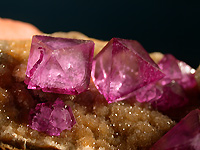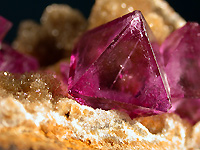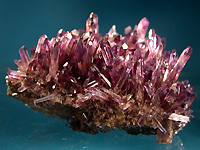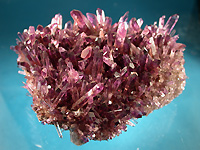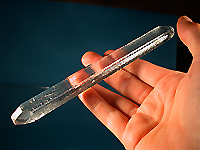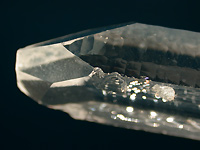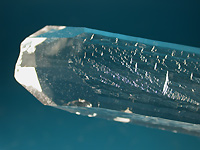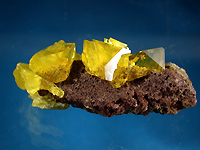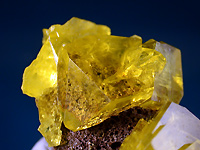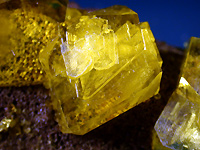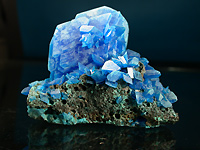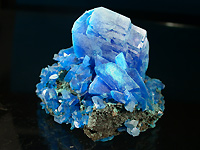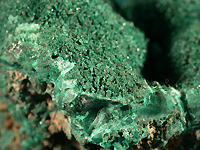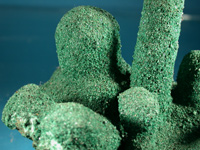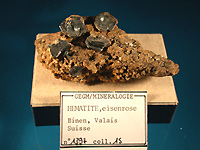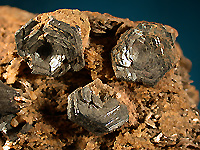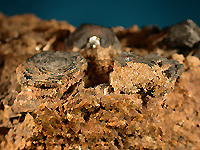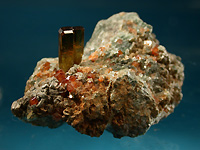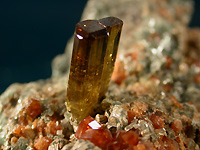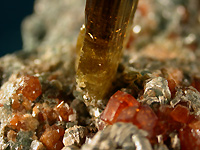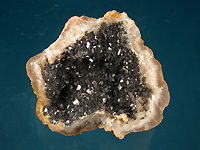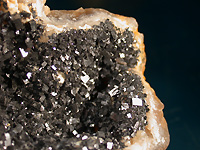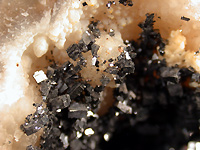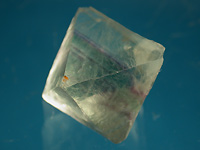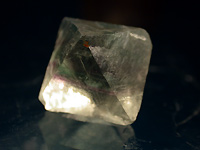The
book "Valzergues fluorite mine"
![]() E.
Guillou-Gotkovsky
E.
Guillou-Gotkovsky
![]() Comments
Comments
![]() How
to get the book
How
to get the book
Falses and diverses
| TRAPS TO BE AVOIDED US VERSION (to be translated... thank you for your patience!!!) | ||||||||||||||||||||||||||||||||||||||||||||||||||||
|
The
text presented here is not to make us play a role " upholders of the law"
in mineralogy, but just to show you some modifications, arrangements or forgeries(imitations)
which we are all susceptible to meet one day. We can distinguish several categories: The synthesis: take some common salt ( NaCl), dissolve some grams in some water (50ml and once the totally made dissolution, pour your mixture into a ramekin which you will forget voluntarily on the height of a cupboard, for example (immovable place - in theory!). When all the water will be evaporated, you will find beautiful small cubic crystals. The same system, in the industrial scale (and with techniques considerably more developed - Verneuil processing...) allows to form ruby crystals (used in lasers), diamonds (very small and used as abrasive for saws)... We saw, a few years ago, some crystals of copper sulphate which were spectacular but now forbidden for sale because of young children poisoning.
The irradiated specimen: It is a question of giving a more "commercial" appearance. The typical example is the morion quartz of Arkansas. Initially, it is white, crystal clear and after gamma irradiation, it turns black and brilliant. So, it is sold better thanks to some hours of human intervention... The natural irradiation, on the other hand, takes several thousand years: morion quartz of the "Massif Central", the alpine smoked quartz... How to recognize natural irradiated of the artificial irradiated? We are only giving tracks... The warmed specimen: Classic phenomenon and "successful candidate" (under certain reserves, notably that to warn the buyer!) in gemology. The most common examples are:
-
topaz: very blue, it is very possible that it was warmed. But there are
blue topazes not warmed in sharply rarer quantity... The examples are numerous... The restuck specimen (in place): it occurs for specimens of big rarity, either those to whom the collector will attach a sentimental importance for example. Some pink fluorites of the "Mont Blanc" were restuck in place on quartz smoked on which they had developed. We can see also the example with the esmerald on gangue... The honesty would want that we indicate this repair during the sale. It's the same for specimen with strengthened gangue to avoid that all the specimen to be transformed into puzzle!
The stuck specimen.. with different minerals (the "mineralogical medley"): we find them according to the mineralogical culture of the manufacturers. Indeed, some will not dare to associate a fluorite to an agathe!!!! But others will dare completely plausible more subtle associations: the association of 2 minerals of same format, but from different places...
In the same genre and very common, we find the " Berber geodes ": these are geodes of chalcedony whose mineralogical interest is limited, and on which we papered the inside of galena cubes (different sizes for specimens more elaborated!). This is made by depositing a film of glue then by placing some cubes obtained by natural cleavage of the galena. The rest of the geode is then performed with residues of cleavage (powder) of the galène, which are going to stick in the not yet busy zones. It is the archetype of the "false specimen"...
The modified specimen: it is necessary to distinguish the the face and the back. Here, we only present the mineralogical interesting face (example: the crystallized malachite). On the other hand the work on the back of the specimen cannot be considered as a imitation. About the modification of the crystallizations, this can be made by various chemical and\or mechanical means. An example was a quartz which had undergone some small shocks during its extraction. This specimen had an important value. To present it without showingit has been hand modified, some fluorhydric acid had been used to give a natural aspect to the breaks (*)
DO NOT MERGE WITH... The
work on the matrix(back of the specimen) : il nous semble indispensable de
parler ici de ce travail qui peut être effectué avec plus ou moins
de finesse, en fonction des moyens techniques dont on dispose. Le nettoyage des minéraux : Là aussi, certains puristes diront qu'un minéral ne doit pas être nettoyé, et présenté tel qu'il a été trouvé. Il est extrêmement rare de trouver un minéral qui ne soit pas sali, soit par des oxydes de fer, soit par de la "boue", ou bien par d'autres produits secondaires qui découlent de l'altération de la roche encaissante et qui sont plus ou moins tenaces. Une fluorine (par exemple!), aussi belle et brillante soit-elle, sous une couche d'oxydes de fer ne présente aucun intérêt. Pour cela des produits divers peuvent être utilisés. Le plus difficile est d'utiliser celui (ou ceux) qui n'ont pas d'action destructrice sur la cristallisation qui nous intéresse... La Revue "Le Règne Minéral" présente depuis le mois de juin 2004 des méthodes de nettoyage. Nous parlions d'utilisation d'acides pour mettre en valeur des pièces minéralogiques. Certes, il peut y avoir une dérive comme mentionnée ci dessus (voir *), mais son utilisation est particulièrement bien adaptée pour dissoudre le quartz de certain échantillons qui seraient invibles sans ce procédé. A titre d'exemple, nous pouvons prendre les derniers octaèdres de fluorine chinoise qui sont initialement noyés dans le quartz. Leur couleur bleu-vert est ainsi mise en valeur. Mais ceci s'est également vu pour quelques rares pièces de fluorine et barytine du Maroc qui étaient dissiulées sous plus d'un centimètre de quartz marron, sale... et sans aucun intérêt minéralogique.
Ainsi, et nous le répétons, ceci n'a pour but que de developper un petit peu l'esprit critique du lecteur. Nous n'avons pas la prétention de tout savoir, mais nous tenons juste à informer quant aux surprises que l'on peut découvrir... Par
ailleurs, si vous êtes en posséssion d'un"faux" ou specimen
qui n'est pas "conforme aux lois naturelles", vous pouvez aussi nous
le faire savoir. Spathfluor se fera un plaisir d'enrichir cette rubrique... en
restant discret, cela va de soi!
Remerciements aux collectionneurs qui nous ont confié leurs échantillons.
| ||||||||||||||||||||||||||||||||||||||||||||||||||||
![]()
